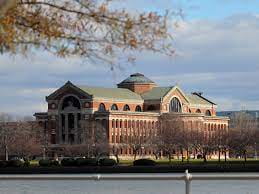 Before World War II, each of the military services would take their enrollees and train them according to their respective field’s best practices. As the Cold War began, the need for the various branches of the military to collaborate and educate each other began to increase. This resulted in the Defense Department colleges gradually combining the many forces of the military under one umbrella.
Before World War II, each of the military services would take their enrollees and train them according to their respective field’s best practices. As the Cold War began, the need for the various branches of the military to collaborate and educate each other began to increase. This resulted in the Defense Department colleges gradually combining the many forces of the military under one umbrella.
The National Defense University (NDU) began in 1976 and consisted of the 1) Dwight D. Eisenhower School for National Security and Resource Strategy and the 2) National War College. In 1981, the 3) Joint Forces Staff College was added to the university. A year later, the 4) College of Information and Cyberspace joined. The university’s newest school is the 5) College of International Security Affairs, which was created in 2002.
D. Eisenhower School for National Security and Resource Strategy and the 2) National War College. In 1981, the 3) Joint Forces Staff College was added to the university. A year later, the 4) College of Information and Cyberspace joined. The university’s newest school is the 5) College of International Security Affairs, which was created in 2002.
The mission of NDU is “to educate joint Warfighters in critical thinking and the creative application of military power to inform national strategy and globally integrated operations, under conditions of disruptive change, in order to conduct war.”
 The vision of NDU is “to create strategic advantage by developing joint warfighters and other national security leaders and forging relationships through whole-of-nations and whole-of-government educational programs, research and engagement.”
The vision of NDU is “to create strategic advantage by developing joint warfighters and other national security leaders and forging relationships through whole-of-nations and whole-of-government educational programs, research and engagement.”
NDU’s purpose is stated as “Educating, Developing and Inspiring National Security Leaders.”
In addition to the 5 colleges within National Defense University, there is a research institute, an international student program, a library, a gaming and simulation center, and relationships with organizations throughout D.C. Students represent all the military services, along with many federal agencies, private sector companies, and partner nations.
institute, an international student program, a library, a gaming and simulation center, and relationships with organizations throughout D.C. Students represent all the military services, along with many federal agencies, private sector companies, and partner nations.
Leading the research program is the Institute for National Strategic Studies (INSS), which focuses research on key issues ranging from complex operations, to technology and weapons of mass destruction. INSS also serves as a think tank and is one of the primary venues in the nation’s capital for scholarly expertise on national security issues.
Students are selected to attend the National Defense University – they cannot apply. Almost 100% of the students graduate in the time allotted and almost 100% of their graduates are employed during their enrollment and after graduation.
apply. Almost 100% of the students graduate in the time allotted and almost 100% of their graduates are employed during their enrollment and after graduation.
Through its International Student Management Office, NDU hosts more than 100 International Fellows each year, who study in the university’s colleges and develop a deeper understanding of American government and society.

The size of the colleges within National Defense University (NDU) varies but range from 162 (CIC) to 1,288 (JFSC) for a total of just over 3,000. The NDU’s budget in 2015-2016 was ~$85M. Interesting, besides the table above, most of this data came from 2015-2016, as during the last President’s administration, no annual reports were provided.
The campus’ various buildings are primarily located in D.C. at Fort McNair and Norfolk.

National Defense University is accredited by the Middle States Commission on Higher Education, and was initially accredited in 1997. Some of the most interesting programs I discovered included:
- Master of Arts in Strategic Security Studies (MASSS)
- Counterterrorism Fellowship (CTF) Program
- South and Central Asia Security Studies Program (SCAP)
- Emerging Threats in the Contemporary Security Environment
- Economics of National Security (ENS)
- Military Technology Diffusion and Asian Defense Markets Dynamics
- Joint Advanced Warfighting School (JAWS)
- Joint Military Deception Training Course
- Alternative Approaches to Exploit and Orchestrate Non-Military Instruments of National Power in the “Rebalance” to Asia
- Arctic security challenges and the strategic positions of the various “Arctic nations”
A center called the “Center for the Study of Chinese Military Affairs (CSCMA)” published extensively on topics like ““The People’s Liberation Army and Contingency Planning in China.”
published extensively on topics like ““The People’s Liberation Army and Contingency Planning in China.”
Another center, started in 1994, called the “Center for the Study of Weapons of Mass Destruction (CSWMD) includes an academic concentration on “Weapons of Mass Destruction Studies.”
 The faculty for NDU published ~150 scholarly papers listed on the last 10 pages of the annual report. Although NDU has 5 colleges within its university, there are other military related universities and colleges including:
The faculty for NDU published ~150 scholarly papers listed on the last 10 pages of the annual report. Although NDU has 5 colleges within its university, there are other military related universities and colleges including:
- Air University (United States Air Force), Alabama
- Defense Acquisition University, Fort Belvoir, Virginia
- National Intelligence University, Washington, D.C.
- NATO Defense College, Rome, Italy
- Naval Postgraduate School, Monterey, California
- Naval War College, Newport, Rhode Island
- U.S. Army War College, Carlisle, Pennsylvania
